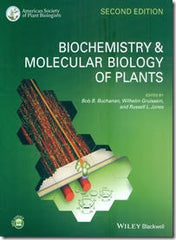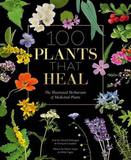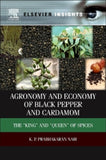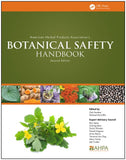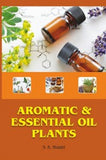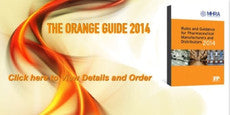Biochemistry and Molecular Biology of Plants, 2nd Edition Bob B. Buchanan (Editor), Wilhelm Gruissem (Editor), Russell L. Jones (Editor)
Description
Since its publication in 2000, Biochemistry and Molecular Biology of Plants, has been hailed as a major contribution to the plant sciences literature and critical acclaim has been matched by global sales success. Maintaining the scope and focus of the first edition, the second will provide a major update, include much new material and reorganise some chapters to further improve the presentation.
This book is meticulously organised and richly illustrated, having over 1,000 full-colour illustrations and 500 photographs. It is divided into five parts covering: Compartments, Cell Reproduction, Energy Flow, Metabolic and Developmental Integration, and Plant Environment and Agriculture. Specific changes to this edition include:
• Completely revised with over half of the chapters having a major rewrite.
• Includes two new chapters on signal transduction and responses to pathogens.
• Restructuring of section on cell reproduction for improved presentation.
• Dedicated website to include all illustrative material.
Biochemistry and Molecular Biology of Plants holds a unique place in the plant sciences literature as it provides the only comprehensive, authoritative, integrated single volume book in this essential field of study.
Table of Contents
List of Contributors xii
Preface xv
About the Companion Website xvi
COMPARTMENTS
1 Membrane Structure and Membranous Organelles 2
Introduction 2
1.1 Common properties and inheritance of cell membranes 2
1.2 The fluid ]mosaic membrane model 4
1.3 Plasma membrane 10
1.4 Endoplasmic reticulum 13
1.5 Golgi apparatus 18
1.6 Exocytosis and endocytosis 23
1.7 Vacuoles 27
1.8 The nucleus 28
1.9 Peroxisomes 31
1.10 Plastids 32
1.11 Mitochondria 39
Summary 44
2 The Cell Wall 45
Introduction 45
2.1 Sugars are building blocks of the cell wall 45
2.2 Macromolecules of the cell wall 51
2.3 Cell wall architecture 73
2.4 Cell wall biosynthesis and assembly 80
2.5 Growth and cell walls 90
2.6 Cell differentiation 99
2.7 Cell walls as sources of food, feed, fiber, and fuel, and their genetic improvement 108
Summary 110
3 Membrane Transport 111
Introduction 111
3.1 Overview of plant membrane transport systems 111
3.2 Pumps 120
3.3 Ion channels 128
3.4 Cotransporters 142
3.5 Water transport through aquaporins 146
Summary 148
4 Protein Sorting and Vesicle Traffic 151
Introduction 151
4.1 The cellular machinery of protein sorting 151
4.2 Targeting proteins to the plastids 153
4.3 Targeting proteins to mitochondria 157
4.4 Targeting proteins to peroxisomes 159
4.5 Transport in and out of the nucleus 160
4.6 ER is the secretory pathway port of entry and a protein nursery 161
4.7 Protein traffic and sorting in the secretory pathway: the ER 175
4.8 Protein traffic and sorting in the secretory pathway: the Golgi apparatus and beyond 182
4.9 Endocytosis and endosomal compartments 188
Summary 189
5 The Cytoskeleton 191
Introduction 191
5.1 Introduction to the cytoskeleton 191
5.2 Actin and tubulin gene families 194
5.3 Characteristics of actin filaments and microtubules 196
5.4 Cytoskeletal accessory proteins 202
5.5 Observing the cytoskeleton: Statics and dynamics 207
5.6 Role of actin filaments in directed intracellular movement 210
5.7 Cortical microtubules and expansion 216
5.8 The cytoskeleton and signal transduction 219
5.9 Mitosis and cytokinesis 222
Summary 238
CELL REPRODUCTION
6 Nucleic Acids 240
Introduction 240
6.1 Composition of nucleic acids and synthesis of nucleotides 240
6.2 Replication of nuclear DNA 245
6.3 DNA repair 250
6.4 DNA recombination 255
6.5 Organellar DNA 260
6.6 DNA transcription 268
6.7 Characteristics and functions of RNA 270
6.8 RNA processing 278
Summary 288
7 Amino Acids 289
Introduction 289
7.1 Amino acid biosynthesis in plants: research and prospects 289
7.2 Assimilation of inorganic nitrogen into N ]transport amino acids 292
7.3 Aromatic amino acids 302
7.4 Aspartate ]derived amino acids 318
7.5 Branched ]chain amino acids 326
7.6 Glutamate ]derived amino acids 330
7.7 Histidine 333
Summary 336
8 Lipids 336
Introduction 337
8.1 Structure and function of lipids 337
8.2 Fatty acid biosynthesis 344
8.3 Acetyl ]CoA carboxylase 348
8.4 Fatty acid synthase 350
8.5 Desaturation and elongation of C16 and C18 fatty acids 352
8.6 Synthesis of unusual fatty acids 360
8.7 Synthesis of membrane lipids 365
8.8 Function of membrane lipids 373
8.9 Synthesis and function of extracellular lipids 382
8.10 Synthesis and catabolism of storage lipids 389
8.11 Genetic engineering of lipids 395
Summary 400
9 Genome Structure and Organization 401
Introduction 401
9.1 Genome structure: a 21st ]century perspective 401
9.2 Genome organization 404
9.3 Transposable elements 416
9.4 Gene expression 422
9.5 Chromatin and the epigenetic regulation of gene expression 430
Summary 436
10 Protein Synthesis, Folding, and Degradation 438
Introduction 438
10.1 Organellar compartmentalization of protein synthesis 438
10.2 From RNA to protein 439
10.3 Mechanisms of plant viral translation 447
10.4 Protein synthesis in plastids 450
10.5 Post ]translational modification of proteins 457
10.6 Protein degradation 463
Summary 475
11 Cell Division 476
Introduction 476
11.1 Animal and plant cell cycles 476
11.2 Historical perspective on cell cycle research 477
11.3 Mechanisms of cell cycle control 482
11.4 The cell cycle in action 488
11.5 Cell cycle control during development 497
Summary 506
ENERGY FLOW
12 Photosynthesis 508
Introduction 508
12.1 Overview of photosynthesis 508
12.2 Light absorption and energy conversion 511
12.3 Photosystem structure and function 519
12.4 Electron transport pathways in chloroplast membranes 529
12.5 ATP synthesis in chloroplasts 537
12.6 Organization and regulation of photosynthetic complexes 540
12.7 Carbon reactions: the Calvin–Benson cycle 542
12.8 Rubisco 548
12.9 Regulation of the Calvin–Benson cycle by light 551
12.10 Variations in mechanisms of CO 2 fixation 557
Summary 565
13 Carbohydrate Metabolism 567
Introduction 567
13.1 The concept of metabolite pools 570
13.2 The hexose phosphate pool: a major crossroads in plant metabolism 571
13.3 Sucrose biosynthesis 573
13.4 Sucrose metabolism 577
13.5 Starch biosynthesis 580
13.6 Partitioning of photoassimilates between sucrose and starch 587
13.7 Starch degradation 593
13.8 The pentose phosphate/triose phosphate pool 597
13.9 Energy and reducing power for biosynthesis 601
13.10 Sugar ]regulated gene expression 606
Summary 608
14 Respiration and Photorespiration 610
Introduction 610
14.1 Overview of respiration 610
14.2 Citric acid cycle 613
14.3 Plant mitochondrial electron transport 620
14.4 Plant mitochondrial ATP synthesis 632
14.5 Regulation of the citric acid cycle and the cytochrome pathway 634
14.6 Integration of the cytochrome pathway and nonphosphorylating pathways 635
14.7 Interactions between mitochondria and other cellular compartments 639
14.8 Biochemical basis of photorespiration 646
14.9 The photorespiratory pathway 648
14.10 Role of photorespiration in plants 652
Summary 655
METABOLIC AND DEVELOPMENTAL INTEGRATION
15 Long ]Distance Transport 658
Introduction 658
15.1 Selection pressures and long ]distance transport systems 658
15.2 Cell biology of transport modules 664
15.3 Short-distance transport events between xylem and nonvascular cells 668
15.4 Short ]distance transport events between phloem and nonvascular cells 673
15.5 Whole ]plant organization of xylem transport 691
15.6 Whole ]plant organization of phloem transport 696
15.7 Communication and regulation controlling phloem transport events 705
Summary 710
16 Nitrogen and Sulfur 711
Introduction 711
16.1 Overview of nitrogen in the biosphere and in plants 711
16.2 Overview of biological nitrogen fixation 715
16.3 Enzymology of nitrogen fixation 715
16.4 Symbiotic nitrogen fixation 718
16.5 Ammonia uptake and transport 735
16.6 Nitrate uptake and transport 735
16.7 Nitrate reduction 739
16.8 Nitrite reduction 744
16.9 Nitrate signaling 745
16.10 Interaction between nitrate assimilation and carbon metabolism 745
16.11 Overview of sulfur in the biosphere and plants 746
16.12 Sulfur chemistry and function 747
16.13 Sulfate uptake and transport 750
16.14 The reductive sulfate assimilation pathway 752
16.15 Cysteine synthesis 755
16.16 Synthesis and function of glutathione and its derivatives 758
16.17 Sulfated compounds 763
16.18 Regulation of sulfate assimilation and interaction with nitrogen and carbon metabolism 764
Summary 767
17 Biosynthesis of Hormones 769
Introduction 769
17.1 Gibberellins 769
17.2 Abscisic acid 777
17.3 Cytokinins 785
17.4 Auxins 795
17.5 Ethylene 806
17.6 Brassinosteroids 810
17.7 Polyamines 818
17.8 Jasmonic acid 821
17.9 Salicylic acid 826
17.10 Strigolactones 830
Summary 833
18 Signal Transduction 834
Introduction 834
18.1 Characteristics of signal perception, transduction, and integration in plants 834
18.2 Overview of signal perception at the plasma membrane 838
18.3 Intracellular signal transduction, amplification, and integration via second messengers and MAPK cascades 843
18.4 Ethylene signal transduction 847
18.5 Cytokinin signal transduction 850
18.6 Integration of auxin signaling and transport 852
18.7 Signal transduction from phytochromes 857
18.8 Gibberellin signal transduction and its integration with phytochrome signaling during seedling development 861
18.9 Integration of light, ABA, and CO2 signals in the regulation of stomatal aperture 866
18.10 Prospects 870
Summary 870
19 Molecular Regulation of Reproductive Development 872
Introduction 872
19.1 The transition from vegetative to reproductive development 872
19.2 The molecular basis of flower development 881
19.3 The formation of male gametes 889
19.4 The formation of female gametes 897
19.5 Pollination and fertilization 902
19.6 The molecular basis of self ]incompatibility 908
19.7 Seed development 913
Summary 923
20 Senescence and Cell Death 925
Introduction 925
20.1 Types of cell death 925
20.2 PCD during seed development and germination 930
20.3 Cell death during the development of secretory bodies, defensive structures and organ shapes 932
20.4 PCD during reproductive development 937
20.5 Senescence and PCD in the terminal development of leaves and other lateral organs 940
20.6 Pigment metabolism in senescence 948
20.7 Macromolecule breakdown and salvage of nutrients in senescence 951
20.8 Energy and oxidative metabolism during senescence 957
20.9 Environmental influences on senescence and cell death I: Abiotic interactions 961
20.10 Environmental influences on senescence and cell death II: PCD responses to pathogen attack 964
20.11 Plant hormones in senescence and defense ]related PCD 974
Summary 982
PLANT ENVIRONMENT ANDAGRICULTURE
21 Responses to Plant Pathogens 984
Introduction 984
21.1 Pathogens, pests, and disease 984
21.2 An overview of immunity and defense 985
21.3 How pathogens and pests cause disease 989
21.4 Preformed defenses 1009
21.5 Induced defense 1012
21.6 Effector ]triggered immunity, a second level of induced defense 1022
21.7 Other sources of genetic variation for resistance 1032
21.8 Local and systemic defense signaling 1033
21.9 Plant gene silencing confers virus resistance, tolerance, and attenuation 1042
21.10 Control of plant pathogens by genetic engineering 1044
Summary 1050
22 Responses to Abiotic Stress 1051
Introduction 1051
22.1 Plant responses to abiotic stress 1051
22.2 Physiological and cellular responses to water deficit 1054
22.3 Gene expression and signal transduction in response to dehydration 1061
22.4 Freezing and chilling stress 1068
22.5 Flooding and oxygen deficit 1076
22.6 Oxidative stress 1085
22.7 Heat stress 1094
22.8 Crosstalk in stress responses 1097
Summary 1099
23 Mineral Nutrient Acquisition, Transport, and Utilization 1101
Introduction 1101
23.1 Overview of essential mineral elements 1102
23.2 Mechanisms and regulation of plant K+ transport 1103
23.3 Phosphorus nutrition and transport 1113
23.4 The molecular physiology of micronutrient acquisition 1118
23.5 Plant responses to mineral toxicity 1127
Summary 1131
24 Natural Products 1132
Introduction 1132
24.1 Terpenoids 1133
24.2 Biosynthesis of the basic five ]carbon unit 1135
24.3 Repetitive additions of C5 units 1138
24.4 Formation of parent carbon skeletons 1141
24.5 Modification of terpenoid skeletons 1143
24.6 Metabolic engineering of terpenoid production 1145
24.7 Cyanogenic glycosides 1146
24.8 Cyanogenic glycoside biosynthesis 1152
24.9 Functions of cyanogenic glycosides 1157
24.10 Glucosinolates 1158
24.11 Alkaloids 1159
24.12 Alkaloid biosynthesis 1164
24.13 Biotechnological application of alkaloid biosynthesis research 1171
24.14 Phenolic compounds 1178
24.15 Phenolic biosynthesis 1185
24.16 The phenylpropanoid ]acetate pathway 1188
24.17 The phenylpropanoid pathway 1195
24.18 Universal features of phenolic biosynthesis 1202
24.19 Evolution of secondary pathways 1205
Summary 1206
Further reading 1207
Index 1222
Related Products
-
100 Plants That Heal: The Illust...
1,700.00
2,000.00 -
A Textbook of Modern Toxicology,...
8,942.00
10,520.00 -
Agronomy and Economy of Black Pe...
2,495.00
10,995.00 -
Aloes: The Genus Aloe edited by ...
2,446.00
2,795.00 -
American Herbal Products Associa...
8,400.00
9,500.00 -
Aromatic and Essential Oil Plants
1,450.00
- Architecture & Construction Management Books
- Biochemistry, Bioengineering and Biotechnology Books
- Books on Analytical Techniques, GC MS, LC, TLC, HPLC, NMR Spectroscopy
- Books on Water and Wastewater Treatment, Analysis Water Treatment Plants
- Chemical Technology, Organic Chemistry, Chemical Synthesis and Chemical Analysis Books
- Cosmetics Science, Cosmetics Formulations, Manufacture and their Analysis Books
- Drugs and Pharma Science Books
- Essential Oils, their Analysis, Natural Products Extraction, Distillation , Isolates Related Books
- Flavor Science, Flavor Analysis, Flavor Creation, Food Flavors Books
- Food Science and Technology, Baking , Food Ingredients , Food Quality , Food Regulations
- Formulations of Perfumes for Agarbatti, Air Freshners, Soaps & Detergents, Fabric Softeners , French style Perfumes, Attars , OUD, Fine Fragrances
- Fragrances, Scents, Attars , Perfumery and Aroma Chemicals Books
- Herbal, Ayurvedic, Medicinal Plants and Aromatic Plants Books
- Law Books
- Major Reference Works (MRWS) Sets - MultiVolume Sets
- Medical Books
- Medical Journals Wolters Kluwer | Medknow India
- NEW ARRIVALS
- Perfumer's Resources
- Special Indian Reprint !



